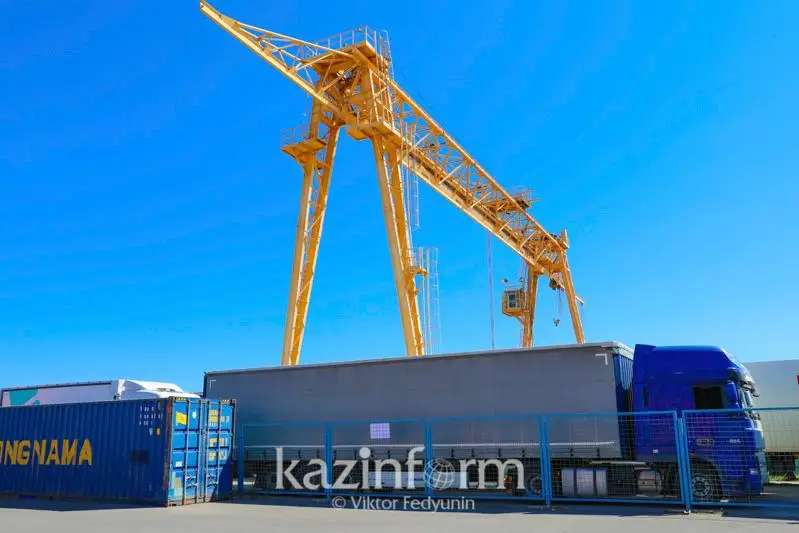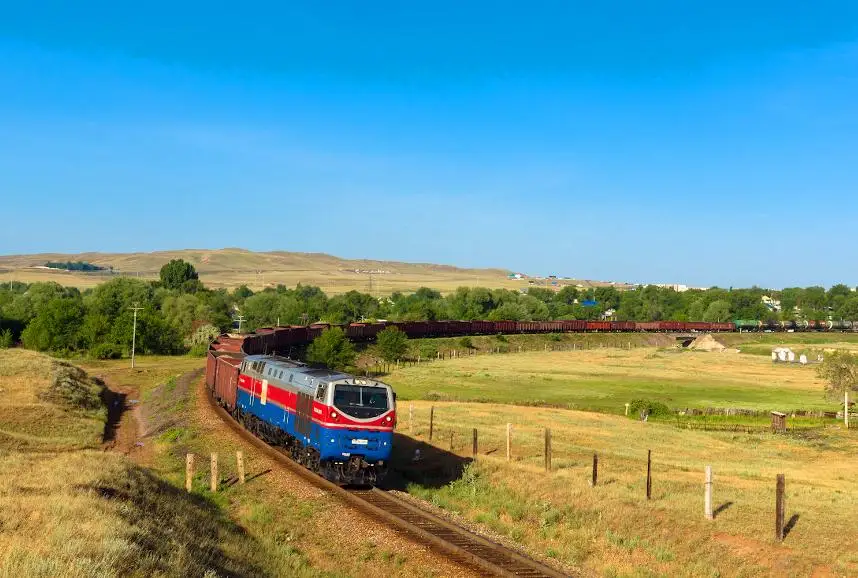Untangling threads: Addressing connectivity challenges in Central Asia

What is connectivity?
Contrary to the broad public perception of connectivity merely in terms of transport and corridors, connectivity, in fact, encompasses a wide range of dimensions, including physical infrastructure, digital networks, transportation systems, and cultural exchanges. At its core, connectivity refers to the ability to link people, places, and ideas, creating a seamless web of communication and interaction that transcends geographical boundaries.
Digital infrastructure lies at the forefront of connectivity, which has revolutionized the way information is accessed and shared. High-speed internet connectivity enables individuals to connect with the world, fostering global communication, e-commerce, and knowledge exchange and contributing to the rise of remote work, online education, telemedicine, and e-government services, leading to increased efficiency, innovation, and inclusivity.

Connectivity rhetoric
Enhanced connectivity can serve as a catalyst for economic growth and development by facilitating the flow of goods, services, and information, enabling businesses to expand their reach, access new markets, and participate in global value chains.
The Middle Corridor, also known as the Trans-Caspian International Transport Route, is a crucial part of the discussion on connectivity, as the current challenges, including shifting global trade flows, force countries to find ways to diversify traditional trade routes.
The route starts from Southeast Asia and China and runs through Kazakhstan, the Caspian Sea, Azerbaijan, Georgia and further to European countries.

President Kassym-Jomart Tokayev spoke multiple times on the need to foster connectivity.
In Central Asia, a region abundant in natural resources and historical heritage, connectivity is of paramount importance.
«Even a quick glance at the map shows the unique geographical location of Central Asia at the junction of Russia, China, South Asia, the Middle East and the South Caucasus. In the new geopolitical realities, the role of our region in promoting and developing transcontinental trade is rapidly increasing. In these circumstances, Kazakhstan is actively developing the Trans-Caspian International Transport Route. Since 2017, the transportation of containers along the routes of this corridor has increased almost threefold to 25,000,» he said at the Consultative Meeting of the Heads of State of Central Asia in Cholpon-Ata in July 2022.
The countries in this region, despite being neighbors, face both challenges and opportunities in establishing robust networks that connect them with each other and the wider world. Addressing these challenges and harnessing the potential benefits of connectivity is essential for their progress and prosperity.

However, achieving comprehensive connectivity requires concerted efforts from governments, private sector stakeholders, and international cooperation. Investment in infrastructure development, policy reforms, and regulatory frameworks is crucial to overcome barriers and bridging the digital divide.
Often, inconsistent policies, burdensome regulations can hinder the development of efficient and competitive network infrastructure.
Connectivity and trade
Managing Director of the World Economic Forum Mirek Dusek spoke about the trends in global trade and how it shapes connectivity.
«There is this realization that we are in some kind of a transition economically in the world economy. It is important that we realize this is not a linear transition. We really don’t know what the destination is,» he told a panel session at the Astana International Forum on June 9.
One of the global trends is that the world witnesses growth in global trade, a record high year for the United States and China trade of almost $700 billion, and China and EU trade of $600 billion.
«Nominally, we have major trade volumes. Obviously, we need to be aware of the risks and headwinds,» he said.
The second trend is the deployment of digital tools to facilitate trade, and the third is that trade becomes increasingly greener and «part of the whole momentum toward a net zero economy in the future.»
«There are major efforts that we need to do much more in terms of greening transportation links that we have in the global economy,» he said. «The other big factor is how then you are able to be part of this value chain around new clean energy economy of the future.»

Connectivity and transport corridors
The EU and the European Bank for Reconstruction and Development (EBRD) recently embarked on the study of sustainable transport links between Europe and Central Asia, meant to identify the most sustainable transport connections between Central Asian economies and the extended Trans-European Transport Network.
The findings were presented on May 19, which concluded that Central Trans-Caspian Network, «traversing through southern Kazakhstan, is identified as the most sustainable option, allowing for further transport network and regional development by taking a two-layer catchment area approach that spans the territory of all five Central Asian countries and covering most of the major population and production centers of the region.»

«All of these alternatives, let me say it very clear, have their own advantages and are not mutually exclusive. But they are in different phase of development,» said Zsuzsanna Hargitai, Managing Director for Central Asia at the EBRD.
«One of the main factors why we put emphasis on the Сentral Сorridor is because it connects major production centers in more than one country. That is simple. You’ve got there Shymkent, Almaty, Tashkent, Namangan. That’s where we see regional cooperation and supply chain coming from,» she said.
The study proposes seven soft connectivity measures and 32 hard infrastructure investment needs. Soft connectivity measures refer to «low-cost, high-benefit action items which can yield significant benefits to the implementing countries and the wider Central Asian region.» These measures may include digitalizing transport documents, improving interoperability, trade facilitation, market liberalization, and improving tariff-setting mechanisms.
«There are things that the study calls soft measures, which I think are the hardest measures. That is intergovernmental cooperation, it means harmonization of customs documentation, and transport documentation. It would increase already the efficiency of existing network four-fold,» she said.
Overall, the region will need at least between 18 to 20 billion euros in total investment to significantly improve the Central Trans-Caspian Network. If these measures are implemented, transit container volume on the Central Trans-Caspian Network can increase from 18,000 twenty-foot equivalent units (TEU) as of 2022 to 865,000 TEUs by 2040, entailing a free-flow transit time of 13 days.

«If there is one message I say, it is high time to establish a platform for coordination and action. We are delighted by the study. We’ve consulted all stakeholders, government operators, and private sector operators. It’s time to move to action. We would to like to support, may be, potentially lead it,» she said.
Besides investment in physical infrastructure, there is a need to address bottlenecks that might appear on the western shore of the Caspian and the eastern shore of the Black Sea, according to William Tompson, Head of the Eurasia Division of the Organization for Economic Cooperation and Development (OECD).
The organization has been working on trade and transport connectivity challenges in Kazakhstan and Central Asia for several years, including the OECD’s first big report in 2019 with the support of Kazakhstan.
It shifted emphasis from transport policy and transport infrastructure, corridors and infrastructure bottlenecks to what Tompson described as softer measures, such as trade facilitation.
«We better talk here about integration, not just connectivity, transit or transport, but economic integration. We don’t want to make Central Asia simply a vast piece of real estate through which other people are running very fast trains, and where they may be some benefit from constructing those rail lines at a certain point, but it will be limited,» said Tompson.

Private sector should be more involved
The private sector will benefit from a single commercially-oriented operator, according to Zsuzsanna Hargitai.
«Now, various operators need to strike individual deals with individual asset owners, and the transaction costs are high. This is one of the reasons why this corridor is not used more. Not only Central Asia but overall Middle Corridor operators could very much benefit from the establishment of a commercial oriented single corridor operator. Shippers would like to have one interface,» said the EBRD officials.
Tompson echoed her remarks about the need for better coordination.
«It requires a level of coordination that will have to go beyond occasional intergovernmental agreements. (...) There needs to be a coordinating body, made up of participating states, organized with some real economic incentives to ensure that it has a reason to run efficiently and operate on a very commercially sound basis,» said Tompson.

Miroslav Dusek from the World Economic Forum said it is important to achieve economy of scale (refers to cost advantages that arise when the scale of production or operation increases) around corridors.
«The more it is connected, the bigger market around it, maybe other private sector players will be more interested in this environment. (...) We want to make sure, given the strategic value of this corridor for Kazakhstan and other economies, that actors that are relevant in the global economy know about the project. It needs to be future-oriented, when something is being built, it is built for the future,» said Dusek, emphasizing it is not only the corridor but should be a market system.
Demographic shifts influencing connectivity
Addressing the panel session of the Astana International Forum on June 8, the Director of the Kazakhstan Institute of Strategic Studies Yerkin Tukumov spoke about demographic trends influencing the region and its connectivity capacity.
Tukumov referred to the term coined by Moises Naim, a three-revolution, which is taking place around the world - a revolution of multitude, a revolution of mobility and a revolution of mentality. The «revolutions» framework is explored in Naim’s book «The End of Power: From Boardrooms to Battlefields and Churches to States, Why Being In Charge Isn't What It Used to Be.»
Naím argues that traditional forms of power are experiencing significant erosion and are being disrupted by forces that challenge established hierarchies. He identifies three key revolutions that are reshaping power dynamics in various sectors.
«Revolution of multitude. It is already happening. 30 years ago, it was only 50 million people in Central Asia. Now it’s 80 million people. By 2050, it’s going to be 100 million people. We’re going to be bigger and bigger in terms of population,» said Tukumov.

Life expectancy is also increasing to 70 years, while poverty is declining, for example, In Tajikistan, from 37 percent to 30 percent, and in Kazakhstan, from 65 percent in 2001 to 10 percent five years ago.
«In terms of mobility, more and more people are traveling within the countries and abroad. The level of urbanization is growing, reaching 61 percent in Kazakhstan. More people have better access to education, healthcare, internet and new technologies,» he said.
Mentality is the most important aspect, according to him.
«The average age is under 30. It means they were born after the collapse of the Soviet Union. There is no nostalgia for these old gold times. What we have in a nutshell - we have a younger population under the 30s, more open to new technologies, more urban, more educated, they have a more critical approach to power institutions, and they bring a lot of challenges to the current model of public administration,» he said.
According to Tukumov, the region, where political leaders enjoy a trust-based dialogue, needs a united approach to the region, which has been misperceived for many years,
«Everything starts with trust. What we really miss is united approach to the region, which is mispresented for many years. (...) We don’t want to take a side. We want that Central Asia should be a field for cooperation not battle,» he said.
However, Tukumov warned experts against making any misjudgments in the process of integration.
«We’ve done a lot of these misperceptions before. Now we don’t have this chance,» he said.

Regulations and connectivity
Making regulations right will help boost connectivity, particularly between people, said Aziza Umarova, an expert on the political economy and development in Central Asia.
Umarova said there is an «uncharted terrain» in Central Asia which could benefit from new regulation, deregulation, and ease of doing business.
«Less government engagement means more private sector engagement,» she said.
She told a positive story of how the efforts of the Kazakh Ministry of Trade and Integration to give access to Kazakh producers on Amazon in 2021 actually had surprising outcomes. Since May 20, 2021, Kazakhstan’s entrepreneurs have been able to sell goods on Amazon, one of the largest international e-commerce platforms.
«To our surprise, the negotiation embarked on all five countries of Central Asia. Now, any part of Central Asia can be present as a seller on Amazon. Kazakhstan did it because they realized the value that would be created even if somebody is exporting not from Kazakhstan but, let’s say, from Tajikistan. Kyrgyzstan and Uzbekistan, with the three countries enjoying GSP+ (Generalized Scheme of Preferences) preferential treatment with EU markets,» she said.

People-to-people contacts
Connectivity can boost tourism in Central Asia. Countries have seen an increase in tourist arrivals.
«Uzbekistan opened up to the world. We waived visas to nationals from 92 countries. That definitely had implications on a number of travels that took place in Uzbekistan, and we have 11 international airports. Last year, Uzbekistan flew 8 million passengers, and this year's forecast is 9.3 million. We are already 30 percent above pre-COVID levels,» said Aziza Umarova.
The year the country waived visas, more than 1 million Tajik nationals crossed the border.
«That just shows you the potential of integration in Central Asia at least at the level of people to people if you do regulations right,» she said.
However, experts agreed that we can hardly talk about connectivity in the region if people do not have direct air travel between neighboring countries. Launching direct air travel must be a priority, they suggested.

Addressing these challenges requires a multi-faceted approach involving investment in infrastructure, policy reforms, capacity building, regional cooperation, and private sector engagement. The increased dialogue between the region’s leaders gives hope these obstacles can be overcome and empower Central Asian countries to drive transformation, and unlock the socio-economic benefits.